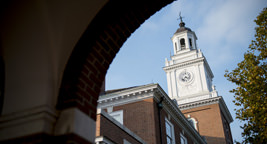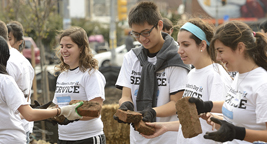Institution Building
To strengthen our position as one of the world’s premier academic research institutions, Johns Hopkins must marshal the required resources, policies, and arrangements to support the advancement of our academic mission.
This includes gathering information and creating processes that appropriately inform our decision making; fortifying our competitiveness for federal and other research funding; and growing our endowment through philanthropy and other sources of investment.
Through these efforts, we will build an even stronger university, one that is able to invest strategically in our core academic priorities and the groundbreaking discoveries of tomorrow.
The Goals
Strengthen the institutional, budgetary, technological, and policy frameworks necessary to set priorities, allocate resources, and realize the highest standards of academic excellence.
To meet the challenges before us and strengthen our position as one of the world’s premier academic institutions, the university will need to construct processes and mechanisms that empower informed and considered decision making; increase capacity for data generation, aggregation, and analysis; and allocate resources in a manner that aligns with our principles and mission.
Since the original Ten by Twenty, the university undertook a range of such initiatives, in areas such as sustainability, combating sexual assault, cross-university branding, and the history of the university. We also undertook a comprehensive self-study, a singular opportunity for reflection and assessment across the university. As we move forward, our polestar must continue to be programs and processes that adhere to best practices, prioritize self-evaluation and informed decision making, and safeguard our commitments to innovation and excellence.
Reinforce our position as the leading university recipient of competitively funded federal research support, while increasing the amount of annual research investment from other sources with appropriate cost recovery.
Federal funding fuels our institution. However, we are operating in a time of undeniable fiscal uncertainty, and so our reliance on federally sponsored research funding leaves us vulnerable to further reductions. The university must continue to develop forward-looking strategies to enhance our competitiveness for federal funding while we diversify our relationships with nonfederal resources for research support.
To this end, the university has expanded its connections with a broader constellation of partners: the private sector, through a sweeping new set of investments in innovation and entrepreneurship; the state of Maryland, through the new E-Nnovation program and a new high performance computing center; and an expanded range of federal agencies, such as those involved in military health. Many of these efforts are in their early stages, but of central importance to each in the coming years will be the deep integration of the work into the academic, research, service, and clinical missions of the university.
Develop the resource base necessary to support investments in key academic priorities.
Since the merchant Johns Hopkins made his original investment, the university has been the recipient of extraordinary acts of philanthropy. These commitments have launched lifesaving innovations, fueled fundamental discoveries, and touched the lives of countless students. Even so, the university faces considerable resource challenges, with a relatively modest endowment and smaller pools of funding at the central or divisional level. The university must calibrate its approach to the financial framework of our university, coupling new lines of revenue with targeted initiatives for cost control.
The last two fiscal years were the most successful fundraising years in the university’s history, with a total of more than $1.43 billion raised in that time span alone. We also saw more involvement than ever from our alumni in helping to build these resources for future generations of students. Finally, those efforts were coupled with a new cross-university, faculty-led effort to leverage our collective purchasing power to lower costs and improve services; this initiative is expected to produce nearly $10 million in savings in the first year, all of which will benefit faculty research and related budgets. The emphasis of each of these endeavors has been on empowering and investing in the people who make up Hopkins, a focus that will only grow in the coming year.



